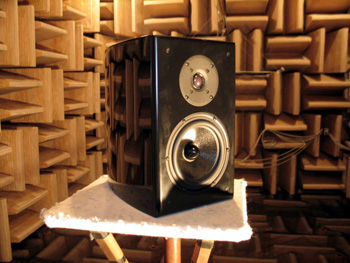Buy or DIY?

The Kepler in NRC's anechoic chamber.
|
Last month,
I wrote about the general need for education about audio gear, for consumers and reviewers
alike. As if on cue, this month I had a learning experience of my own.
The other day, Colin Smith, an avid do-it-yourselfer
(DIYer) who writes the "D-I-Why
& How" column for SoundStage!, dropped by to show me the Kepler, a
stand-mounted speaker kit he’d put together that was designed by the folks at
www.DIYCable.com. For $249 USD per speaker ($498/pair), DIYCable.com sells the drivers and
crossovers, as well as instructions on how to put them all together. As for the cabinet,
you can build your own, or buy pre-made ones from Parts Express for just under $200/pair.
The PE cabinets need holes cut out of the baffle for the drivers, but are otherwise ideal
for the DIYCable.com design -- and they’re what Colin used.
All told, a pair of completed Keplers has a parts cost of
about $700. What’s more, Colin said, they weren’t all that tough to put together
-- for a DIYer. (If I’d built them, it would likely be a different story --
I’m no audio handyman. In fact, they might not be finished even now . . . )
Completely assembled, the Kepler is an impressive sight
that looks as if it might cost upward of $1500/pair ready-made. The pair of them sounded
as if they’d cost that much, too. We listened to Colin’s Keplers in my
listening room, and the only stand-mounted speakers I had on hand that I liked better cost
$1500/pair or more. In fact, the Keplers so impressed me that, shortly after that session,
I suggested that we measure one of them in the anechoic chamber of Canada’s National
Research Council. This kit-based speaker was about to get the full-blown
speaker-measurement treatment in a state-of-the-art sound lab.
Without getting into all the nitty-gritty details, the
NRC’s charts revealed that, overall, the Kepler performed wonderfully, with a very
linear frequency response both on and off axis, and very low distortion even at high
output levels. (Those charts will be presented in full when Colin’s article about the
speakers is published in SoundStage!) Furthermore, the Kepler’s impedance
remains over 6 ohms, and is smooth in a way that would make the speakers ideal partners
for tube amps -- something that Colin also builds for himself.
Based on those results and the listening we did, the Kepler
thoroughly impressed me -- and I suspect others will be, too. In fact, after hearing all
this, one question you might have is: Why do people buy ready-made audio components
when they can get such great value from DIY projects? It seems such an obviously good
way to go. But when you look around, you see that the overwhelming majority of people buy
stuff that comes fully assembled in a box, even if it costs much more. Why?
There are a number of reasons, but I suspect the main thing
has to do with something that PSB’s Paul Barton said to me a short time ago (I
paraphrase): "Some people look at things like speakers and say, I could make
something just like that, and they do. But most people look at the same speakers and
say, I could never make something like that, so they don’t even try." As
a result, speaker companies such as PSB are often quite large, and DIY companies are
almost always very small.
Still, Colin’s visit with the Keplers, and our
subsequent trip to the NRC, reminded me that there can be tremendous value in going the
DIY route, but only if the right person attacks the project -- someone with skilled hands
who is willing to invest the time it takes to build such a kit. Colin’s that type of
guy; I’m not. You can decide for yourself where you fit in.
Before Colin’s visit, I knew a little bit about DIY,
but my experience with the Kepler opened my eyes and ears to a world of high-quality,
high-value, do-it-yourself hi-fi that I hadn’t known existed. I’ve learned
something new: I never knew that a kit speaker could sound and look so good.
…Doug Schneider
E-mail comments to the editor@goodsound.com.
|